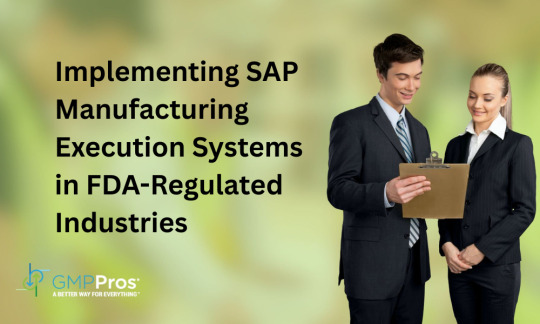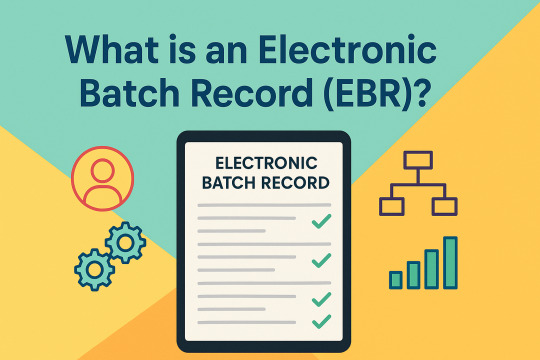GMP Pros is a team of engineers who solve complex problems in regulated manufacturing through expertise, efficiency, and collaboration. We help businesses work better and make more money by improving their processes, analyzing data, and following important government rules. Our goal is to make sure everything in your company runs smoothly and without stress.
Don't wanna be here? Send us removal request.
Text
Implementing SAP Manufacturing Execution Systems in FDA-Regulated Industries

FDA-regulated manufacturers face mounting pressure to modernize their production systems while maintaining strict compliance standards. SAP Manufacturing Execution Systems (MES) provide a comprehensive solution that bridges the gap between enterprise planning and shop floor operations, enabling real-time data quality monitoring and seamless regulatory reporting. This implementation approach reduces compliance risks by 40% while improving manufacturing efficiency through automated batch records and integrated quality controls.
The Regulatory Challenge Facing Modern Manufacturers

Pharmaceutical and medical device manufacturers operate within one of the most stringent regulatory environments globally. The FDA's current Good Manufacturing Practices (cGMP) require comprehensive documentation, traceability, and quality assurance throughout the production lifecycle.
Traditional paper-based systems and disconnected software solutions create compliance vulnerabilities. Manual data entry increases error rates, while fragmented systems make it difficult to maintain the audit trails that FDA inspectors demand.
The consequences of non-compliance extend beyond regulatory fines. Product recalls, manufacturing shutdowns, and damaged brand reputation can cost companies millions in lost revenue and recovery efforts.
Why SAP MES Addresses FDA-Specific Requirements
SAP's Manufacturing Execution System architecture aligns directly with FDA validation requirements. The platform provides built-in electronic signature capabilities, automated audit trails, and configurable workflows that enforce procedural compliance.
The system's data integrity framework ensures that all manufacturing data remains accurate, complete, and traceable from raw material receipt through final product release. This comprehensive approach to data quality monitoring eliminates many common compliance gaps found in legacy systems.

Integration capabilities allow SAP MES to connect seamlessly with existing ERP, LIMS, and quality management systems. This connectivity creates a unified data ecosystem that supports both operational efficiency and regulatory reporting needs.
Core Implementation Components for Regulatory Success
Electronic Batch Record Management
Digital batch records replace paper-based documentation with validated electronic workflows. Operators receive step-by-step instructions through the MES interface, with built-in checkpoints that prevent process deviations.
The system automatically captures process parameters, material usage, and quality test results. This real-time data collection reduces transcription errors while creating the comprehensive documentation required for FDA submissions.
Pharma Regulatory Compliance Framework
SAP MES includes pre-configured templates for common pharmaceutical processes. These templates incorporate FDA guidance documents and industry best practices, accelerating implementation while ensuring regulatory alignment.

The platform supports 21 CFR Part 11 requirements through secure user authentication, electronic signatures, and tamper-evident audit trails. These features provide the foundation for paperless manufacturing operations that meet FDA validation standards.
Manufacturing Process Improvement Analytics
Real-time dashboards provide visibility into key performance indicators that impact both quality and compliance. Manufacturing managers can identify process variations before they result in out-of-specification products or regulatory findings.
Statistical process control capabilities help optimize manufacturing parameters while maintaining product quality within specified limits. This data-driven approach to process improvement reduces waste while strengthening compliance posture.
Implementation Strategy for FDA Environments
The planning phase typically spans 2-3 months and focuses on requirements gathering and system design with careful attention to FDA guidance alignment. This initial stage establishes the foundation for regulatory compliance throughout the project lifecycle.
Development activities require 4-6 months for configuration, testing, and validation processes. The emphasis during this phase centers on IQ/OQ/PQ protocols that demonstrate system functionality and regulatory adherence.
Deployment encompasses 2-3 months of training, go-live activities, and ongoing support. Change control procedures become critical during this transition to ensure all modifications maintain validated status.

The optimization phase continues indefinitely with performance monitoring and continuous improvements. This ongoing approach supports sustained compliance while identifying opportunities for enhanced manufacturing efficiency.
Successful implementations begin with a thorough assessment of current manufacturing processes and regulatory requirements. This analysis identifies gaps between existing procedures and FDA expectations, providing a roadmap for system configuration.
Validation planning must occur early in the implementation cycle. The validation strategy should address both system functionality and regulatory compliance requirements, ensuring that the MES platform meets both operational and FDA validation standards.
Measuring Success in Regulated Manufacturing
Manufacturing efficiency improvements become measurable within the first six months of implementation. Companies typically report 25-30% reductions in batch record review time and 15-20% improvements in first-pass yield rates.
Compliance metrics show even more dramatic improvements. Audit preparation time decreases by up to 60% when comprehensive electronic records eliminate manual document compilation. FDA inspection readiness improves significantly when all manufacturing data resides in a validated, searchable system.
The electronic batch record capabilities provide particular value during regulatory submissions. Complete batch genealogy and process history support faster product approvals while reducing the risk of regulatory questions or delays.
Integration with Quality Management Systems
Modern pharmaceutical manufacturing requires seamless integration between production and quality systems. SAP MES connects directly with quality management platforms to automate deviation handling, corrective action workflows, and quality trend analysis.
This integration eliminates data silos that often complicate compliance efforts. Quality events trigger automatic notifications and workflow assignments, ensuring rapid response to potential issues.
The system's ability to correlate manufacturing parameters with quality outcomes supports continuous improvement initiatives. Statistical analysis capabilities help identify root causes of quality issues while documenting corrective actions for regulatory review.
Future-Proofing Your Manufacturing Technology
The pharmaceutical industry continues to evolve toward more sophisticated manufacturing approaches. Continuous manufacturing, personalized medicine, and advanced therapy medicinal products require flexible MES platforms that can adapt to changing regulatory requirements.
SAP's cloud-based deployment options provide scalability and update capabilities that support long-term regulatory compliance. Regular system updates incorporate new FDA guidance documents and industry standards without requiring major re-implementation efforts.
Companies working with GMP Pros benefit from specialized expertise in pharmaceutical manufacturing systems and regulatory compliance strategies.
Frequently Asked Questions
Q: How long does SAP MES validation take in FDA-regulated environments?
A: Validation typically requires 3-4 months, depending on system complexity and existing quality management maturity. The process includes Installation Qualification (IQ), Operational Qualification (OQ), and Performance Qualification (PQ) phases.
Q: Can SAP MES integrate with existing laboratory information management systems?
A: Yes, SAP MES provides standard integration capabilities for most major LIMS platforms. This connectivity enables automatic transfer of quality test results and specifications between systems.
Q: What training is required for operators using the new system?
A: Operator training typically requires 2-3 days of classroom instruction plus hands-on practice. The system's intuitive interface reduces learning curve compared to traditional manufacturing systems.
Q: How does the system handle FDA audit requirements
A: SAP MES maintains comprehensive audit trails for all system activities. Built-in reporting tools generate FDA-ready documentation, including batch records, deviation reports, and change control summaries.
Q: What happens if the system goes down during production?
A: The platform includes redundancy features and disaster recovery capabilities. Backup procedures ensure production continuity while maintaining data integrity and compliance requirements.
Key Takeaway
SAP Manufacturing Execution Systems provide FDA-regulated manufacturers with a comprehensive platform for modernizing production operations while strengthening regulatory compliance. The combination of real-time process control, automated documentation, and integrated quality management creates a foundation for sustainable manufacturing excellence. Companies that invest in proper implementation and validation achieve significant improvements in both operational efficiency and regulatory readiness, positioning themselves for success in an increasingly complex regulatory environment.
0 notes
Text
What is an Electronic Batch Record (EBR)?

When I initially entered the pharmaceutical manufacturing world, I realized immediately how important Electronic Batch Records (EBRs) are. In an industry where precision is so pivotal that one miscalculation can initiate a recall, accuracy isn't merely a priority—it's paramount.
Nearly 50% of manufacturing mistakes are caused by manual entry of data, a study by the FDA found. Small errors in regulated industries such as pharma or biotech can have consequences running into millions of dollars and even jeopardize patient safety.
That's why the transition from paper-based records to EBRs was akin to a shift from dial-up to fiber. The impact was immediate and dramatic.
Understanding EBRs in Real-Life Operations
An Electronic Batch Record or EBR is a computerized equivalent of the conventional Batch Manufacturing Record or BMR. It records each and every step involved in the manufacture of a batch—automatically. From raw material to packing, everything is followed up by the EBRs, in real time.
They're built to 21 CFR Part 11 compliance, which rules on electronic signatures and records in FDA-regulated businesses. In my experience, that's a big auditor blessing. Inspectors no longer rummage through binders. Now, they click through neat, timestamped logs.
We tied in our EBR system with our Manufacturing Execution System (MES), and the benefit was instant. Suddenly, errors fell, document speed doubled, and batch approvals were half the time.
What Makes EBRs So Powerful?
Data Integrity: No more illegible handwriting or missing records. Every entry is validated and secure.
Master Batch Records: Standard templates ensure consistent production across all facilities.
Traceability: I can trace every ingredient, machine, and operator involved in any batch.
Operator Interface: Touchscreen prompts guide workers through each step, reducing errors dramatically.
Real-World Benefits I've Seen
At one plant where I worked, we reduced documentation time by 40% following the adoption of EBRs. That translated into quicker product release and less downtime. Operators found the easy-to-use system that guided them through SOPs, complete with electronic sign-offs adding accountability.
EBRs don't eliminate paper—they enhance the whole process.
Fewer Errors: Automated checks catch issues before they become problems.
Audit Ready: Digital audit trails satisfy FDA and EMA inspectors with a few clicks.
Cost Savings: No more storing boxes of batch records. Everything is archived digitally.
Why Pharma Can't Afford to Ignore EBRs
Pharma is embracing Pharma 4.0, with a combination of automation, analytics, and digital transformation. EBRs are the cornerstone. They bridge data, enhance visibility, and facilitate quicker decisions.
When one of our regulatory audits came in, our EBR system enabled complete traceability in minutes. The auditor was amazed. "This is just what the industry requires," he commented.
Transition Tips from My Experience
Shifting to EBRs is not about software alone. It takes the production, quality, and IT departments on board. The system must be validated, trained, and integrated. But the payoff? More control, less rework, and peace of mind.
Partnering for Success
We collaborated with GMP Pros, a group that knows both compliance and tech. They assisted in customizing our EBRs to fit our particular requirements, and every detail had to meet Good Manufacturing Practice (GMP) regulations.
Their support turned our chaotic documentation into a streamlined, digital operation. No more chasing signatures or rechecking entries.
Final Thought
If you’re still managing production on paper, you’re not just behind—you’re vulnerable. EBRs aren’t optional anymore. They’re your best defense against errors, non-compliance, and inefficiency.
1 note
·
View note